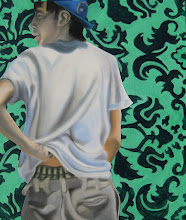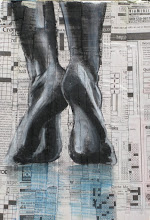DRAWING/PAINTING 2 - Bowie Art Department 2011-2012
Course Objectives:
You are taking Drawing 2 because:
a. You like art.
b. You are good at art.
c. You survived Art 1 and still like art.
d. You are serious about art.
My point is this – every student in this class has a desire to create. If you did not, you would not be here. You are here to study art, both why it exists and why you need to create it. You will be discovering territories you did not know existed – from self-expression to historical movements. How you create depends on your individual response to the world around you.
We learn not only from what is around us presently but what we came from. This course will attempt to make connections to your work through weekly study of the history of art.
Course of Study:
Perspective, Line, Value: Students will unlock the basis of all drawing and the understanding of what we truly see and how to capture it on a 2 dimensional surface. Work will be from life and study of the masters. Materials will be charcoal, pencil, ink.
Contour/Cross-Contour: Everything in nature starts with something very simple called “turning of the form”. From human anatomy to trees to sea shells students will learn to draw 3 dimensional life by seeing through touch as well as sight. Work will be from observation using charcoal and conte with wash.
Landscape: This often maligned subject is not just what is seen from outside a window. It is both a response to the environment and what you see internally. Students will study landscape from both a traditional and conceptual perspective. Exploration of the subject will be a study of pastel instruction.
Still Life Instruction: Students will compose and create images through direct observation. This is the beginning of life drawing and will incorporate composition, design, value and color.
Design: An all-encompassing topic, the design component in Drawing 2 will cover the gamut from embossing and composition to poster design and illustration. Students will learn the technique of embossing, and design through graphics and typography in poster creation along with the art of illustration in advertising.
Portraiture: Each year advanced students are required to use themselves as models in the study of portraiture. Self portraits begin the student on the path to understanding how to work from live models, required in Art 3 and Advanced Placement. Materials vary year to year, along with techniques taught.
Watercolor: Painting is an important field of study and watercolor, with its infinite possibilities, is the final assignment. The emphasis will be on technique, exploration of personal style and painting from observation.
Art History:
From the beginning of time man has felt the need to create. It is important to understand and see how society has evolved and my contention is that there is no better way than through the study of art history. Every 12 weeks throughout the year we will be studying either a movement, time period or famous artist beginning with the Prehistoric period and culminating in present day Modern Art. Emphasis is on critiquing art through a historian’s eyes. Creative assignments to demonstrate understanding will be given.
Sketchbooks:
Sketchbooks are required and are a major portion of student grades. This is an advanced class and there is a higher expectation of the quality and creativity of work. The time spent on projects is significantly more than what was expected in Art 1. Students must acquire, create or purchase a sketchbook as a record of REGULAR creative thinking outside the classroom. Sketchbook work is assigned every week.
Sketchbook Assignments:
Students will be given 30 assignments. Each entry used must labeled on the back of the sketchbook page.
Date your entries.
Subject matter is your choice based on each assignment selected.
Quality work is expected. The amount of effort you display is very obvious.
Sketchbook work is to be done outside of class.
The Assignments:
1. Sketchbook Cover: Create cover on your sketchbook based on your identity. Media: Cut paper, collage, drawing, painting, words, etc.
2. Draw a Pile of Shoes: Zoom in. Fill up the page. Extend the composition to all four sides of the paper. Do it in pencil, ink, charcoal or other media. Can be line, tone, contour, crosshatching, etc.
3. Advertisement of Yourself: What would you like to say about yourself? Use mixed media to create an advertisement of yourself.
4. Reflective Surface Study: Combine various reflective surfaces. Draw it.
5. Design a CD Cover: Make up a musical group or create a CD for a group you love. Use color.
6. Media: watercolor, colored pencils, acrylic
7. View of Yourself or Others in a Car Mirror: Any media.
8. Texture Study: Close-up study of a leaf, tree bark, or organic texture. Any medium—cut paper, collage, ink, pencil, watercolor, colored pencil, mixed media.
9. Drapery Study: Must be carefully observed and drawn with 3-dimensional volumes, tonal changes, highlights and shadows.
10.Magnifying Glass: Draw a view through a magnifying glass. Include the magnifying glass. Any media.
11. Cut Square Drawing: Draw/paint a well-developed picture. Cut the picture into squares. Re-arrange and paste the squares in your sketchbook to create a design. Use another medium to add to the drawing. Mixed Media
12. Cemetery at Night: Draw a cemetery at night. Use dramatic lighting. You may want to begin with black paper pasted into your sketchbook. Media: inks, colored pencils, charcoal, pastel, craypas, etc.
13. Close-up Study of a Flower: Look at the artist Georgia O’Keefe. Media: colored pencils, watercolor, inks, pencil, sharpie pens—any or all.
14. Jungle Drawing or Design: Draw/design a view of the jungle. The view can be from below (as if you’re an insect), or from above (as if you’re a bird). Any media.
15. Mixed Media Collage: Choose a newspaper story important to you. Cut it out, use it as a background to past collage images on top. Draw/paint additional images. Include words. Change the scale of things. Integrate large and small shapes.
16. Foreshortened Figure Drawing: Do a drawing of a figure in a foreshortened position
17. Change of Style: Divide the page into 4 equal sections. Draw an object/objects in one section. Repeat the same drawing in the other sections, but change the style of each (representational, abstract, cubist, ink stipple, harmonious, complementary colors.
18. A Pile of Shoes: Draw a pile of shoes.
19. Collage—A Family Portrait: A grouping of photos of you and your family with words, drawn images, mixed media. Express what you think your family is about.
20. Your Feet in a Prone Position: Lie on your bed and draw your feet and what is behind it in a prone position. Make sure you “compose” the picture. Use all four sides of the page.
21. Your Sunglasses: Zoomed in at an interesting angle and what they reflect.
22. Detail of a Portrait Photo Blown Up: Cut out a square (1 ½” x 1 ½”) from a portrait photo and blow it up to the largest square you can make in your sketchbook—10” x 10”.
23. Distortion: Choose an object, person or another thing and distort it, repeat it, enlarge it. Your choice of media.
24. Juxtaposition: Combine unlikely images. Exchange, overlap, or superimpose parts to create unusual relationships and a new synthesis. Use color, mixed media.
25. Fragment an Object, Person or Thing: Split, fragment, invert, rotate, shatter, superimpose, and/or divide an image and then reconstruct it to create a new synthesis of parts.
26. Abstraction: Create an abstraction looking at Paul Klee, Miro, and Kandinsky. Create three versions of the composition in different color schemes. Use color.
27. Negative Space: Look at an area in your home and draw the negative shapes around the objects. On another page in your sketchbook, copy the composition and do something different with it in tone, color or line.
28. One-Point Perspective: Draw/design something using one point perspective. Can be a contour drawing, tonal drawing, colored pencils, or watercolor)
29. Dynamic Brushstrokes: Create something using dynamic brushstrokes, contrast and varied lines. Use color.
30.Photocopied Collage of Face & Body Parts: Photocopy faces and body parts and create a design with actual drawings you made of these parts. Blur parts of the design. Overlap images. Layer.
31. Distorted Interior: Look at a room. Distort it. Create something new from it.
Grades:
Grades will be based on the following criteria:
Quality, quantity and creativity of projects as well as process and progress: 70%
Sketchbooks: 15%
Critiques/Art History: 15%
Extra Credit is not offered. Students may redo work, dependent on circumstances (work was completed in a timely manner and effort put in) for a better grade on anything other than tests and quizzes.
Late work:
Excused absence – 2 days for completion, no point loss
Unexcused absence – 1 day for completion with point reduction equal to 20% of grade
Art Shows and Displays:
Student work will be displayed in the community and District Office and in competitions including VASE and Scholastic Art.
Expectations and Fees:
Respect, respect, respect - for yourself, your instructors and the materials. All advanced art students are responsible for the care and acquisition of their own materials. The art fee requested is a donation that makes the buying of professional materials possible. If you choose to not make the donation, you will be responsible for supplying your own materials throughout the year.
The art fee for 2011 – 2012 is $35.00 made payable to the Bowie Art Department due September 2nd.
Bowie High School is committed to maintaining an atmosphere in which students develop the desire to learn by working in partnership with parents, staff and community.
In order to meet this commitment, every student must be respectful of other students, of the staff and, therefore, of himself. The following rules are intended to help us all be respectful:
1. Use appropriate language. Swearing is not acceptable.
2. Be courteous to everyone. Bullying, harassing and hurtful remarks are not
acceptable.
3. Be attentive to the teacher and other students. Cell phones, head sets, electronic
games and other distractions are to be turned off and put away unless you are given
specific permission to use them.
4. Be on time and come with your materials. Tardiness and absence can effect your
grade. Be here and be ready to learn.
5. Dress appropriately for school. If your attire is inappropriate (i.e., distracting to
the learning process) you will be asked to change it.
6. Eating and drinking in class is a distraction for you and for other students. No food
or drinks, other than water, are permitted in the classroom.
____________________________________
Student Signature Date
____________________________________
Parent/Guardian Signature Date
Sunday, August 21, 2011
Subscribe to:
Post Comments (Atom)





No comments:
Post a Comment